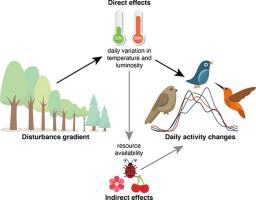当前位置:
X-MOL 学术
›
Forest Ecol. Manag.
›
论文详情
Our official English website, www.x-mol.net, welcomes your
feedback! (Note: you will need to create a separate account there.)
Habitat disturbance can alter forest understory bird activity patterns: A regional-scale assessment with camera-traps
Forest Ecology and Management ( IF 3.7 ) Pub Date : 2021-01-01 , DOI: 10.1016/j.foreco.2020.118618 Francisco E. Fontúrbel , José I. Orellana , Gloria B. Rodríguez-Gómez , Catalina A. Tabilo , Gabriel J. Castaño-Villa
Forest Ecology and Management ( IF 3.7 ) Pub Date : 2021-01-01 , DOI: 10.1016/j.foreco.2020.118618 Francisco E. Fontúrbel , José I. Orellana , Gloria B. Rodríguez-Gómez , Catalina A. Tabilo , Gabriel J. Castaño-Villa

|
Abstract Despite forests are a biodiversity reservoir and a wellbeing source for the humankind, they have been largely disturbed in the past decades. Disturbed and naturally-regenerated forests and forest plantations represent 75% of the world forested area, stressing the need of managing non-pristine forests. While we know that habitat disturbance alters forest structure, reducing species richness and abundances, its effects on animal behavior remain little explored. We used camera traps to test if daily activity patterns of forest birds change along a 450-km disturbance gradient in the Valdivian temperate rainforests of southern Chile. We contrasted bird activity at four conditions: old-growth and second-growth native forests, native forests subject to selective logging, and abandoned exotic plantations with native vegetation. We contrasted habitat structure among conditions and estimated activity kernels to compare bird activity. We also made activity comparisons examining bird foraging guilds (nectarivores, frugivores, and insectivores) and habitat preference (interior vs edge). Habitat structure was different among conditions, being the old-growth native stands the most contrasting habitat. Bird daily activity patterns differed among conditions as well. We observed that bird activity reaches a peak early in the morning at the old-growth native forests, at noon in the plantations, and in the afternoon at the logged forests, while it was more variable in secondary forests. We obtained similar results among bird foraging guilds, but insectivorous birds presented the most contrasting differences. Likewise, we found a similar pattern between forest interior and edge species, which was more evident for forest interior birds. Logged forests presented the largest activity differences, despite being structurally similar to second-growth stands. Forest disturbance not only alters bird species richness and abundance, but also their behavior. Bird daily activity patterns may be directly affected by daily variations in forest microclimate conditions and indirectly affected by chantes in resource availability, which may be affecting their ecological interactions. Therefore, forest management and restoration strategies should take animal behavior into account.
中文翻译:

栖息地干扰可以改变森林林下鸟类的活动模式:使用相机陷阱的区域尺度评估
摘要 尽管森林是生物多样性的水库和人类福祉的源泉,但在过去的几十年里,它们在很大程度上受到了干扰。受干扰和自然再生的森林和人工林占世界森林面积的 75%,这凸显了管理非原始森林的必要性。虽然我们知道栖息地干扰会改变森林结构,减少物种丰富度和丰度,但它对动物行为的影响仍然很少被探索。我们使用相机陷阱来测试森林鸟类的日常活动模式是否沿着智利南部瓦尔迪维亚温带雨林 450 公里的扰动梯度发生变化。我们对比了四种条件下的鸟类活动:原始和二次生长的原生森林、选择性采伐的原生森林以及带有原生植被的废弃外来种植园。我们比较了条件和估计活动内核之间的栖息地结构,以比较鸟类活动。我们还对鸟类觅食行会(食蜜动物、食果动物和食虫动物)和栖息地偏好(内部与边缘)进行了活动比较。栖息地结构因条件而异,古老的原生地是对比最鲜明的栖息地。鸟类的日常活动模式也因条件而异。我们观察到鸟类活动在原始森林的清晨、人工林的中午和采伐森林的下午达到高峰,而在次生林中变化更大。我们在鸟类觅食行会中获得了类似的结果,但食虫鸟类的差异最大。同样地,我们发现森林内部和边缘物种之间存在类似的模式,这在森林内部鸟类中更为明显。尽管在结构上与第二次生长林分相似,但伐木林的活动差异最大。森林干扰不仅会改变鸟类物种的丰富度和丰度,还会改变它们的行为。鸟类的日常活动模式可能直接受到森林小气候条件的日常变化的影响,并间接受到资源可用性的影响,这可能会影响它们的生态相互作用。因此,森林管理和恢复策略应考虑动物行为。森林干扰不仅会改变鸟类物种的丰富度和丰度,还会改变它们的行为。鸟类的日常活动模式可能直接受到森林小气候条件的日常变化的影响,并间接受到资源可用性的影响,这可能会影响它们的生态相互作用。因此,森林管理和恢复策略应考虑动物行为。森林干扰不仅会改变鸟类物种的丰富度和丰度,还会改变它们的行为。鸟类的日常活动模式可能直接受到森林小气候条件的日常变化的影响,并间接受到资源可用性的影响,这可能会影响它们的生态相互作用。因此,森林管理和恢复策略应考虑动物行为。
更新日期:2021-01-01
中文翻译:

栖息地干扰可以改变森林林下鸟类的活动模式:使用相机陷阱的区域尺度评估
摘要 尽管森林是生物多样性的水库和人类福祉的源泉,但在过去的几十年里,它们在很大程度上受到了干扰。受干扰和自然再生的森林和人工林占世界森林面积的 75%,这凸显了管理非原始森林的必要性。虽然我们知道栖息地干扰会改变森林结构,减少物种丰富度和丰度,但它对动物行为的影响仍然很少被探索。我们使用相机陷阱来测试森林鸟类的日常活动模式是否沿着智利南部瓦尔迪维亚温带雨林 450 公里的扰动梯度发生变化。我们对比了四种条件下的鸟类活动:原始和二次生长的原生森林、选择性采伐的原生森林以及带有原生植被的废弃外来种植园。我们比较了条件和估计活动内核之间的栖息地结构,以比较鸟类活动。我们还对鸟类觅食行会(食蜜动物、食果动物和食虫动物)和栖息地偏好(内部与边缘)进行了活动比较。栖息地结构因条件而异,古老的原生地是对比最鲜明的栖息地。鸟类的日常活动模式也因条件而异。我们观察到鸟类活动在原始森林的清晨、人工林的中午和采伐森林的下午达到高峰,而在次生林中变化更大。我们在鸟类觅食行会中获得了类似的结果,但食虫鸟类的差异最大。同样地,我们发现森林内部和边缘物种之间存在类似的模式,这在森林内部鸟类中更为明显。尽管在结构上与第二次生长林分相似,但伐木林的活动差异最大。森林干扰不仅会改变鸟类物种的丰富度和丰度,还会改变它们的行为。鸟类的日常活动模式可能直接受到森林小气候条件的日常变化的影响,并间接受到资源可用性的影响,这可能会影响它们的生态相互作用。因此,森林管理和恢复策略应考虑动物行为。森林干扰不仅会改变鸟类物种的丰富度和丰度,还会改变它们的行为。鸟类的日常活动模式可能直接受到森林小气候条件的日常变化的影响,并间接受到资源可用性的影响,这可能会影响它们的生态相互作用。因此,森林管理和恢复策略应考虑动物行为。森林干扰不仅会改变鸟类物种的丰富度和丰度,还会改变它们的行为。鸟类的日常活动模式可能直接受到森林小气候条件的日常变化的影响,并间接受到资源可用性的影响,这可能会影响它们的生态相互作用。因此,森林管理和恢复策略应考虑动物行为。











































 京公网安备 11010802027423号
京公网安备 11010802027423号